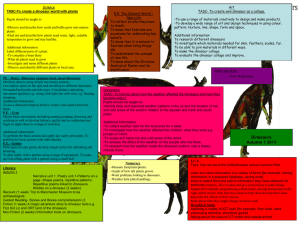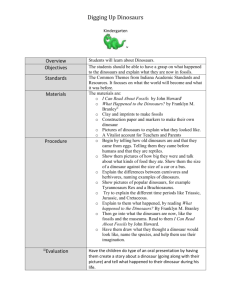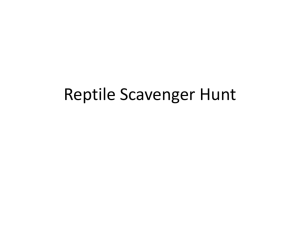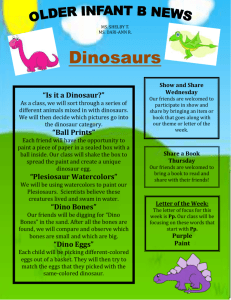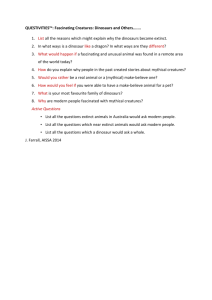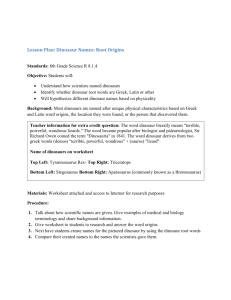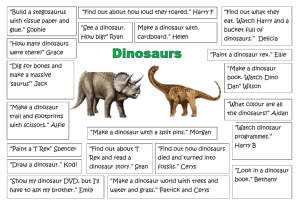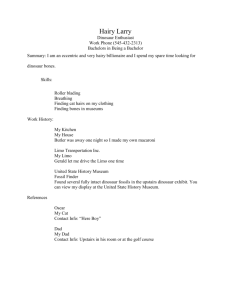GEOL 104 Dinosaurs: A Natural History
advertisement
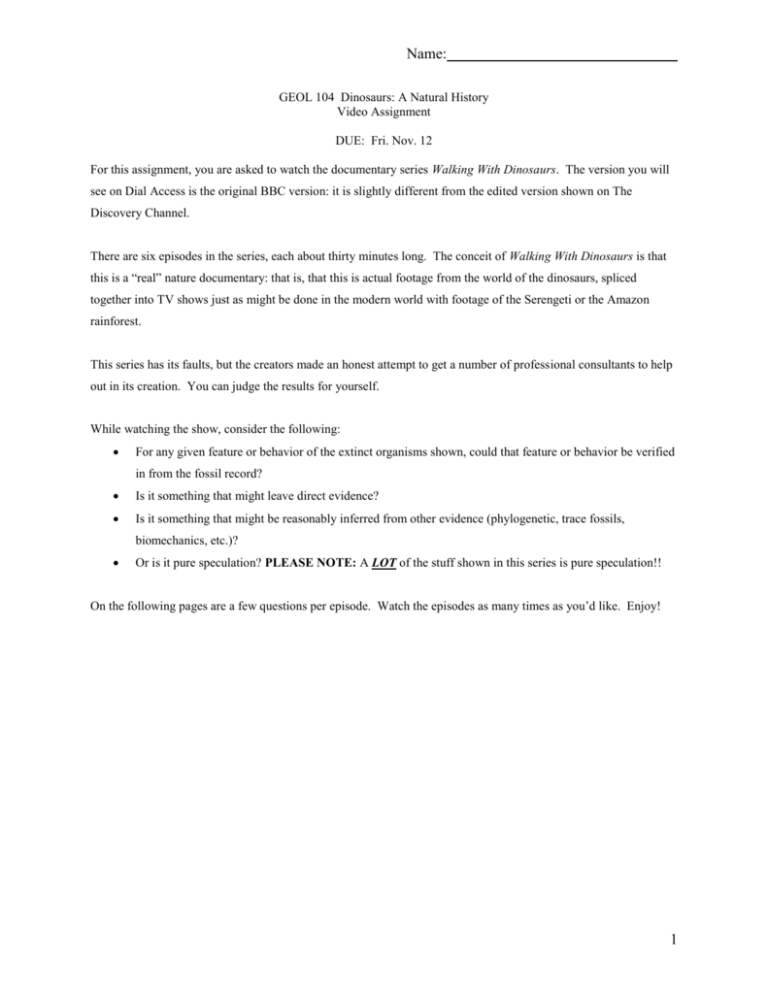
Name: GEOL 104 Dinosaurs: A Natural History Video Assignment DUE: Fri. Nov. 12 For this assignment, you are asked to watch the documentary series Walking With Dinosaurs. The version you will see on Dial Access is the original BBC version: it is slightly different from the edited version shown on The Discovery Channel. There are six episodes in the series, each about thirty minutes long. The conceit of Walking With Dinosaurs is that this is a “real” nature documentary: that is, that this is actual footage from the world of the dinosaurs, spliced together into TV shows just as might be done in the modern world with footage of the Serengeti or the Amazon rainforest. This series has its faults, but the creators made an honest attempt to get a number of professional consultants to help out in its creation. You can judge the results for yourself. While watching the show, consider the following: For any given feature or behavior of the extinct organisms shown, could that feature or behavior be verified in from the fossil record? Is it something that might leave direct evidence? Is it something that might be reasonably inferred from other evidence (phylogenetic, trace fossils, biomechanics, etc.)? Or is it pure speculation? PLEASE NOTE: A LOT of the stuff shown in this series is pure speculation!! On the following pages are a few questions per episode. Watch the episodes as many times as you’d like. Enjoy! 1 Name: Part I: New Blood This episode, set in the Late Triassic Epoch of the American Southwest, represents the dawn of the dinosaurian world as known from the rocks and fossils of the Chinle Formation. (The Chinle is most famous for the Petrified Forest). The cast includes: The early carnivorous dinosaur Coelophysis The plant-eating prosauropod dinosaur Plateosaurus (shows up only at the end) The giant predatory archosaur Postosuchus Two different synapsids, improperly called “reptiles” here even though they aren’t reptiles under the phylogenetic meaning of that term. These protomammals are: o The bulky ox-sized dicynodont Placerias o An unnamed cynodont species The early pterosaur (winged reptile) Peteinosaurus 1) Coelophysis and its kin were among the earliest successful groups of dinosaurs in a world dominated by crocrelatives like Postosuchus and herbivorous synapsids like Placerias. Dinosaurs differed from other Triassic amniotes in a number of ways. Indicate below whether the statements are true or false, based on Walking with Dinosaurs: Coelophysis was larger than Postosuchus and Placerias: Coelophysis operated in groups, whereas both Postosuchus and Placerias only lived alone: Coelophysis was a biped; Postosuchus and Placerias were both quadrupedal while walking: Coelophysis was rather fast; both Postosuchus and Placerias were slower: Coelophysis could kill its own food; Postosuchus was a strict scavenger: 2) Coelophysis is shown cannibalizing its own young during stressful times. How might paleontologists be able to determine that this behavior occurred? Think about clues that might be preservable as fossils and/or as traces of environments of deposition. (The video provides most of the clues needed). 2 Name: Part II: The Time of the Titans This episode is set in the Late Jurassic environment preserved as the Morrison Formation of the American West. It focuses on the birth, growth, and development of a young dinosaur. The cast includes: The giant long-necked sauropod dinosaur Diplodocus The even LARGER long-necked sauropod Brachiosaurus The small carnivorous dinosaur Ornitholestes The large carnivorous dinosaur Allosaurus The plated dinosaur Stegosaurus The pterosaur Anurognathus 1) At birth rhinos weigh 40 kg (88 lbs) and elephants about 100 kg (220 lbs). How do the baby Diplodocus compare? [ much smaller | about the same | much larger ] 2) Adult rhinos weigh about 2 tons; adult elephants up to 8 tons. How do adult Diplodocus compare? [ much smaller | about the same | much larger ] 3) The pterosaur Anurognathus is shown as having a shared beneficial (symbiotic) relationship with Diplodocus. What is the ecological relationship shown? Would such a relationship be easily preservable in the fossil record? How (or why not)? 4) Walking with Dinosaurs portrays Stegosaurus as able to flush blood into its plates, causing them to change color. However, this would work best if they were actually covered by thin skin. The actual fossil evidence suggests that those plates were covered by thicker keratin (horn). Based on this, is the “color flash” hypothesis reasonable? 3 Name: Part III: A Cruel Sea Shown somewhat out of sequence, the assemblage of marine reptiles (and a token dinosaur) here are from the Oxford Clay, which is actually a little older than the Morrison Formation shown in the previous episode (Middle Jurassic Epoch rather than Late Jurassic Epoch). This episode shows some of the different forms of marine life from the mid-Mesozoic. The cast includes: The dolphin-like ichthyosaur Opthalmosaurus The gigantic predatory plesiosaur Liopleurodon The smaller long-necked plesiosaur Cryptoclidus The Mesozoic shark Hybodus The pterosaur Rhamphorhynchus Ammonites, coiled relatives of the modern pearly nautilus, squid, and octopus The carnivorous dinosaur Eustreptospondylus 1) Opthalmosaurus and other ichthyosaurs are known to have given birth live, as shown in this episode. How might that be known from fossils? (The clues are in this episode). 2) Rhamphorhynchus and Eustreptospondylus both live above the water, but their fossils have been found in marine deposits. How might the presence of these reptile fossils in both land and marine formations be useful in terms of determining the ages of marine strata and terrestrial strata? 3) While Opthalmosaurus reproduced in the water, this is not believed to be the case for Cryptoclidus. How do you think it most likely reproduced? 4 Name: Part IV: Giant of the Skies Like the last episode, this one focuses on some non-dinosaurs of the Mesozoic Era (specifically, pterodactyloid pterosaurs). The initial scenes take place in the Santana Formation of Brazil, and later episodes in the Wealden Group (and related deposits) in Europe: both from the Early Cretaceous. The cast is: The crested pterosaur Tapejara The gigantic pterosaur Ornithocheirus (star of the show) The plant-eating dinosaur Iguanodon The armored dinosaur Polacanthus The dromaeosaurid (raptor) Utahraptor, largest known member of the Dromaeosauridae The early toothed bird Iberomesornis 1) In this episode Ornithocheirus is shown making a long migration. The evidence used to suggest this is the presence of fossils of Ornithocheirus in both Brazil and Europe. Can you think of some possible explanations for finding Ornithocheirus in both regions at that time other than migration of individual pterosaurs for the same evidence? (The continents are already known to have been separated at that point, so don’t invoke plate tectonics.) 2) Iguanodon is portrayed as living in herds. What sort of fossil evidence would support this hypothesis? Extra Credit) The mode of attack shown by Utahraptor is typical of what modern group of predatory animals? 5 Name: Part V: Spirits of the Ice Forest This episode portrays the Early Cretaceous assemblage of dinosaurs and other vertebrates found at Dinosaur Cove in Queensland, Australia. During the Cretaceous this location (now on the southeastern coast of Australia) was inland and directly connected to Antarctica. The cast of this episode is: The small ornithopod dinosaur Leaellynasaura The giant amphibian Koolasuchus The large plant-eating dinosaur Muttaburrasaurus An Australian “allosaur” (which may not actually be an allosaur but instead a more primitive meat-eater) An unnamed mammal (curiously played by the modern-day coatimundi, a relative of the raccoon!). 1) The different animals are shown as having different strategies for coping with the long polar winter night. For each taxon, match the name of the creature on the left with the letter of its survival strategy on the right. You may use a letter more than once, but each creature should have only one letter. Not all letters might be used. Koolasuchus: A. Migration to more northern (warmer) lands Leaallynasaura: B. Hibernation in pools during winter. Muttaburrasaurus: C. Staying active in the warmer part of the forest; occasional The allosaur: periods of some hibernation D. Hibernating in feather-lined burrows E. Metabolism changes to become more warm-blooded 2) Muttaburrasaurus has a large sac around its nose. In Walking with Dinosaurs what function did this sac perform? 3) Leaallynasaura is portrayed as having a rather complex social structure. Do you think that the details of this social structure as shown (social dominance hierarchies, particular calls, etc.) might be preservable in the fossil record? If so, how? 6 Name: Part VI: Death of a Dynasty The final episode depicts the Hell Creek Formation dinosaurs and other forms from the latest Late Cretaceous, a very well studied and interesting assemblage of animals from the very end of the Age of Dinosaurs. The cast is: The giant carnivorous dinosaur Tyrannosaurus The early marsupial-relative Didelphodon (which was among the largest of Cretaceous mammals) The duckbilled dinosaur Anatotitan The armored dinosaur Ankylosaurus The horned dinosaurs Torosaurus and Triceratops The giant crocodilian Deinosuchus The giant pterosaur Quetzalcoatlus Unnamed dromaeosaurid (raptor) and hypsilophodont (small bipedal plant-eating dinosaur) genera An early snake 1) Other than the impact of space debris at the end of the episode, several other sorts of environmental problems are shown throughout the episode that are affecting the dinosaur populations. Name one, with extra credit for a second. 2) Torosaurus is shown locking horns to fight, with catastrophic results for one individual. What sort of physical evidence do you think might be left to document this kind of behavior? 3) The idea that any individual Tyrannosaurus rex had to have a large home range is pretty strong on a theoretical basis. Why do you think that an individual giant predator might have to have such a large area all to itself? 7
